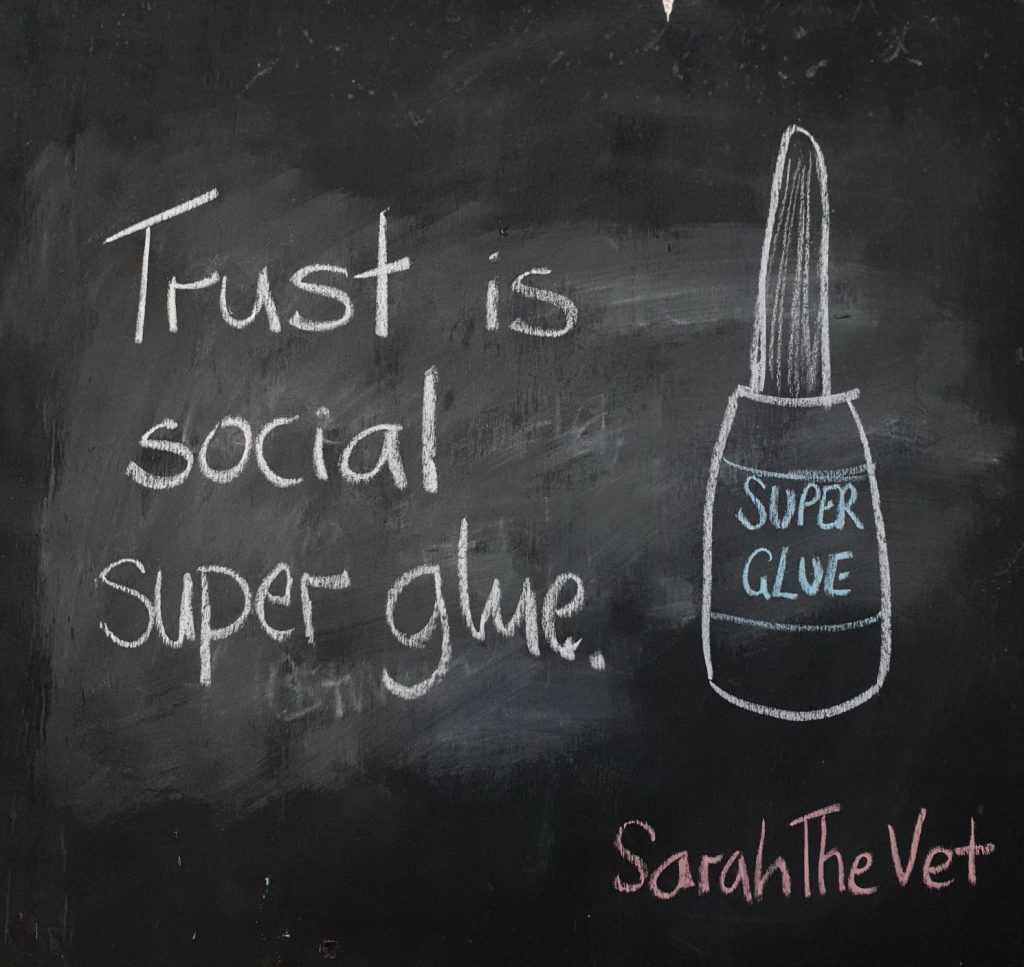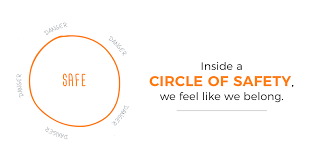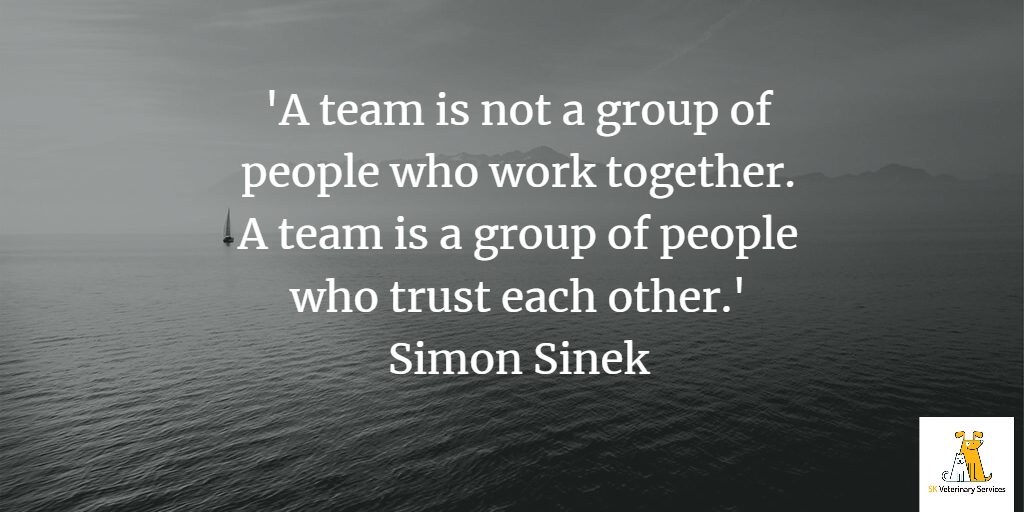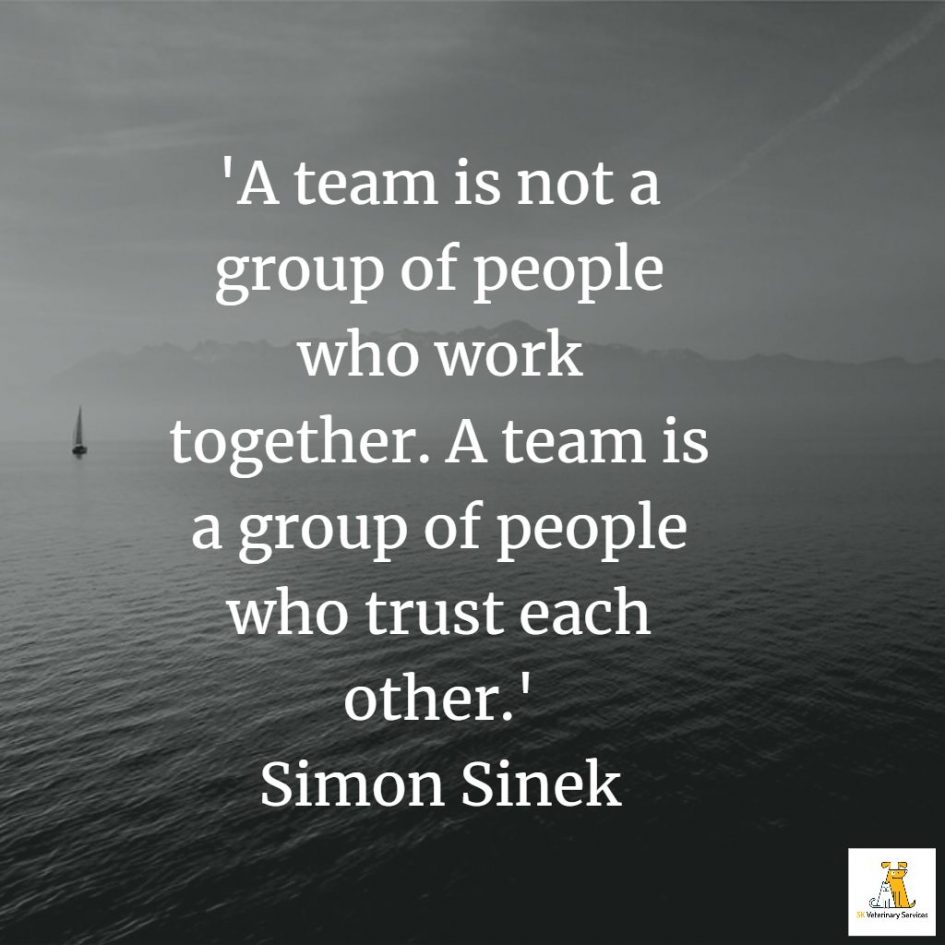Trust. We have great difficulty in describing what trust is because it is just too big, complex and vague to understand – breaking it down into smaller parts makes it much more comprehensible. We often lack the skills or language to talk about trust and so we shy away from the attempt. However, we have a great opportunity to learn how to build and talk about trust and, as I showed in part 1 of this series of articles, building trust is crucial for people and businesses.
The essence of trust is creating safety in relationships in order to have strong connection with and caring for others, which is what our human state wants. Trust can be defined as the extent to which we hold expectations of others in the face of uncertainty about their motives, and yet are willing to allow ourselves to be vulnerable at the same time. To tell if trust is present or not in a relationship, ask yourself do you feel safe sharing what is important to you with this person.

The starting state
Before we talk about how to build trust, we have to realise what state we are building it from; an absence of trust but otherwise neutral state, or the presence of anti-trust such as distrust or betrayal (read my previous article to see if any anti-trust states are present). If starting from the negative, it will be much harder, require different techniques and may even be impossible to get to a positive trust situation; anti-trust states are a barrier to creating trust. Remember that in some circumstances trust may be assumed at the start of the relationship (benefit of doubt), e.g. employee starting a new job, but this trust is extra fragile. If you have taken on a new employee and in the first week they discover the misrepresentation or out-right lie you told them at the interview, this will be a serious barrier to building trust with the employee.
Self-trust
The first step in building trust in others is to have trust in ourselves. Self-trust is the strong conviction in your own integrity. If we don’t trust ourselves, our decisions and have healthy boundaries which we hold on to, then we can’t trust others. The first casualty of failures, mistakes, criticism or regret is our self-trust. If you get hurt, feel shame, or question your worth then we stop trusting ourselves. It is important to have the confidence that you will be kind and respectful to yourself regardless of the outcome of your efforts and you can reflect on you experiences without fear of self-punishment. Key to building self-trust is self-awareness which needs work and often outside guidance, particularly from a coach. We can then build on this to realise where trust wobbles for ourselves and make sure we present ourselves as worthy of someone else’s trust.
Vulnerability
To build trust, you need to share some vulnerabilities with the other person, but if you can’t even admit your vulnerabilities to yourself then you will struggle to get others to trust you. It is false to assume that trust has to be present before there can be vulnerability; it has been shown time and again that vulnerability comes before trust. And this is hard! For a new employee this will be that they have given up a job, perhaps moved across the country or world, which is a vulnerable state. For a leader, this may be them sharing their origin story and journey and the difficulties they have faced.
Learn to talk about trust
We must talk about emotions and how people feel if we are to improve trust, but not everyone is comfortable talking about emotions. Lead by example and regularly use emotional words like “love”, “belonging” and, of course, “trust”. Our vocabulary can be very limited around emotions, so I highly recommend you read the book ‘Atlas of the Heart’ by Brené Brown. We need to identify what trust looks like, what behaviours and what language is used. Look for examples of what trust looks like in other companies and other lines of work and reward these behaviours when you see them. Don’t just have ‘trust’ as an empty value written on the wall or practice handbook – it must be reinforced through constant practice.
Leadership Modelling
Trust ultimately comes from the leadership modelling the behaviour (due to wonderful mirror neurones which respond to actions we observe in others) and thereby building the culture of the workplace, not from the team which might be the initial thought. The problem is most workplaces don’t actively build culture, they just let it happen and are then surprised when it doesn’t turn out how they wanted it to. For some people, and dare I say the majority in the veterinary profession, leadership and its qualities do not come naturally; it will need training, practice and coaching to achieve it. Trust is a feeling not an instruction; you cannot tell someone they can trust you. That’s up to them to decide through your behaviours, actions and language towards them.
Being present
A prerequisite for a leader to build trusting teams is to be present and available; this doesn’t happen if the leader is spending all their time in clinical work, or is not even in the practice except once a week, or they spend their time in the practice in an office at the far end of the building with the door closed. Even if they say they can be disturbed or are always contactable by phone/message, this is not a replacement for actually being there in the team. Leaders need to put time in every day to build trust and it is incredibly hard to build it remotely.
Trusting the team
Trusting their team is one of the risks a leader needs to take in order to lead. Instead of the leader saying ‘team, why should I trust you with this’ or micromanaging their efforts, it is the leader that needs to show behaviours of trustworthiness for the team to trust them. The best way to earn trust is to show trust; give the person some autonomy in how they complete a task or give them a stretch project. Be their coach, not their fixer. Leaders in high-trust workplaces ask for help from their teams and admit when they are wrong, and thereby admitting some of their own vulnerabilities. Creating trust is not soft, not about warm and fuzzy niceness. In fact, creating trust is about being vulnerable – this is not easy as it involves some risk!
Constant, active work
We all need to work on trust in all relationships, constantly and intentionally. We can’t rely on doing one good trust building behaviour and assume the jar of marbles is full for when we may need to take marbles out. Trust is built incrementally out of small behaviours and actions over a period of time. Like the marble jar analogy, the moments that create trust are small and so are the moments of betrayal.
Team building exercises can help build relationships in teams as people can engage with each other without work getting in the way, but on their own they will not create trust, they just put a marble or two in the jar. The time we spend getting to know people when we’re not working is part of what it takes to form bonds of trust. This is especially true when eating together. It has been super hard to do this during the pandemic and increase in practice busyiness but it is essential that time is made to do this. The leaders also need to partake in this social interaction and not hide away.
Safety
For there to be trust, people need to feel safe, emotionally and mentally not just physically. This comes in the forms of reliability (i.e. they can do and will do what they say they will do), trust that you will be treated fairly and without judgement and with compassion, in other words seeing you as a human and demonstrating empathy. Treat everyone at all levels fairly and consistently; friendships in the workplace should not influence decisions. With trust then it is safe to take measured risks (which may include voicing your opinion if it happens to be contradictory to the majority or the boss), to be your authentic self, to talk about emotions, to try something new. The keystone to trusting relationships is if the person will come to you to ask for help or input – as a leader, how many times do people come to you with these requests or do they just bring you problems?

Ideas for building trust in veterinary practices
Here are some practical ideas of mine that I feel are particularly relevant to veterinary businesses to build trust:
- Leadership. Leaders are not born, they are made, they need instruction on how to be good leaders to create trusting teams. Automatically promoting someone who is clinical or senior into a leadership position is not a good idea. They likely have the characteristics that lead to bad leadership and sending them on a few leadership courses is not enough to mould them into a good leader. Leaders need awesome powers of self-awareness – this is the single biggest missing piece in current leadership.
- Get rid of traditional models of leadership built on dominance and command. Millennials and gen Z, the biggest proportion of the workforce currently and will only grow as older generations leave the profession, require different forms of leadership, namely servant and transformative leadership. This is made of shared decision making, delegating tasks and decisions, active listening, supporting others to meet their goals, freedom to be authentic and different, and fairness and integrity.
- Onboarding of new employees is a crucial time. They will start with explicit expectations (the job required, hours, holiday etc) but there is also the implied or psychological contract of expectation – if either contract is broken then trust will be lost. The new start will have started with a small amount of assumed trust on both sides but unless this is built upon, it will stay fragile. Onboarding procedures with new team members is critical, setting out the boundaries for work at the start, have clear procedures and contracts and don’t break them.
- Learn how to give feedback. Everyone needs to give feedback to everyone, not just leaders. Feedback needs to be specific on specific behaviours. There is far too much to write here but feedback in the vet world is either production based (‘your numbers are failing’) or shame/character based (‘you are failing therefore you are a failure’). For more detail I recommend reading this Brené Brown article.
- Clear direction for everyone – what are the mutual goals and what are individuals’ responsibilities within this. Clarity is kindness, therefore sort what the practice is actually standing for, make sure those that work there all stand with it and clarify expectations.
- Relationships with trust need boundaries so be clear and consistent with your boundaries with the people around you. The boundaries and expectations around them need to be voiced and implicit, not implied or assumed. This also means speaking up when your boundaries are crossed, not ignoring them or bending them to try to appease others. Have healthy boundaries yourself and encourage others to have them too. If you don’t know what someone’s boundaries are, then ask them. Speak up if your boundaries are broken – this is commonly a feeling that something is not right if someone asks you to do something or does something that you witness – go with the gut feeling.
- Asking for help builds trust but to give people a safe space to ask for help there needs to be psychological safety. Build a culture where it is OK for colleagues to ask for help for everything from reporting a result on their behalf to supporting them through illness.
- Give people autonomy in how they do their work. Protocols may give efficiency, but overuse of protocols gives the impression to employees that you don’t trust them to do their job or to make the right decisions. Do not micromanage, even if you know you could do the task better. Also, don’t ask people to do something you wouldn’t do yourself.
- Having open conversations and this means being prepared to stay with them if the answer is they are not OK, really wanting to know the answer and being vulnerable in return. Not shutting down the conversation or turning to how you/everyone are struggling. Actively ask how people are doing (and mean it) and ask after their families as this will have the biggest impact on how they are feeling at work. Be there for them when times are good but also when tough (this is reliability). Be vulnerable yourself – there is obvious a balance that mustn’t tip into oversharing but having armour over your vulnerabilities will not allow people to trust you.
- Be reliable and do what you say you will do. If you later find it is not possible then you need to explain to the person who was expecting this of you why it is not possible, potentially giving alternatives. Don’t make promises you can’t keep or don’t intend to keep.
- Build a just culture with accountability at its core. Things will always go wrong, we are only human, but if people are scared to be accountable then your marble jar with them was empty; build that trust first. Accountability is the behavioural aspect of actions (‘when you behave like x, you appear lazy’) whereas judgement is personal (‘you are lazy’). This extends to leadership as leaders need to have the guts to admit things didn’t go as they envisioned they would.
Summary
Trust is a behaviour, not a character and building it requires trust building behaviours. It needs planning, a framework and language. I highly recommend you look at Brené Brown’s work on this, in particular her BRAVING framework for trusting relationships, and Simon Sinek’s work (I recommend you read ‘Leaders Eat Last’). Trust is not a nice to have, it’s a must-have. It is essential capital for all leaders because without it there will be no trust with the team and with no trust there will quickly be no team.
Read more
- Brené Brown and the BRAVING leadership framework
- Simon Sinek Circle of safety from the book ‘Leaders eat last’, 5 practices of building trust, why good leaders make you feel safe.
- An article in the Harvard Business Review.


Leave a Reply